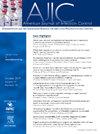追踪空气中的 SARS-CoV-2 RNA:从医务室爆发的 COVID-19 事件中汲取的教训。
IF 3.8
3区 医学
Q2 INFECTIOUS DISEASES
引用次数: 0
摘要
背景:在非典型肺炎爆发期间,SARS-CoV-2 在空气中扩散的持续时间和规模仍不确定。本研究评估了移动式模块化高效微粒空气过滤器(MMHU)对 SARS-CoV-2 空气扩散的影响:方法:我们调查了某医务室爆发的COVID-19疫情。空气样本中的 SARS-CoV-2 病毒载量(VL)与使用或未使用 MMHU 的鼻咽拭子(NPS)中的病毒载量相关。对这些样本进行了全基因组测序(WGS)和系统发育分析:疫情宣布后(2024 年 8 月 2 日,第 0 天),在第 4 天之前,2B 病房(19 名男性)和 2C 病房(25 名女性)的 63 名患者中有 44 人(69.8%)感染了 COVID-19。直至第 11 天(2B 病房)和第 20 天(2C 病房),空氣中仍可檢測到 SARS-CoV-2 的 VL。在 2C 中,空气样本的 VL 与第 5、7、10 和 13 天采集的 NPS 中的 VL 显著相关(r= -0.975,p=0.004)。使用 MMHU,第 5 至 10 天,2B 的 SARS-CoV-2 RNA(拷贝数/1,000 升空气/病人)的日平均比率比 2C 低 5 倍。WGS显示,所有41株检测菌株均属于Omicron变异株KP.3.1.1,在系统发育上与普遍的社区菌株相关:结论:使用 MMHU 可减轻 SARS-CoV-2 在医院内爆发时在空气中扩散的时间和规模。本文章由计算机程序翻译,如有差异,请以英文原文为准。
Tracking SARS-CoV-2 RNA in the air: Lessons from a COVID-19 outbreak in an infirmary unit
Background
The duration and magnitude of SARS-CoV-2 air dispersal during nosocomial outbreaks remain uncertain. This study evaluates the impact of mobile modular high-efficiency particulate air filter units (MMHUs) on SARS-CoV-2 air dispersal.
Methods
We investigated a nosocomial COVID-19 outbreak in an infirmary unit. The viral load (VL) of SARS-CoV-2 in air samples was correlated with the VL in nasopharyngeal swabs with or without MMHU. These samples underwent whole-genome sequencing and phylogenetic analysis.
Results
Upon outbreak declaration (August 2, 2024, day 0), 44 (69.8%) of 63 patients acquired COVID-19 in Ward 2B (19 male) and 2C (25 female) by day 4. The VL of SARS-CoV-2 remained detectable in air until day 11 (2B) and day 20 (2C). The VL of air samples was significantly correlated with the VL in nasopharyngeal swabs collected on days 5, 7, 10, and 13 in 2C (r = − 0.975, P = .004). Using MMHU, the mean daily ratio of SARS-CoV-2 RNA (copies/1,000 L of air/patient) in 2B was 5 times lower than in 2C from days 5 to 10. Whole-genome sequencing revealed all 41 tested strains belonged to the Omicron variant, KP.3.1.1, phylogenetically related to the prevailing community strains.
Conclusions
Using MMHU mitigates the duration and magnitude of SARS-CoV-2 air dispersal during nosocomial outbreak.
求助全文
通过发布文献求助,成功后即可免费获取论文全文。
去求助
来源期刊
CiteScore
7.40
自引率
4.10%
发文量
479
审稿时长
24 days
期刊介绍:
AJIC covers key topics and issues in infection control and epidemiology. Infection control professionals, including physicians, nurses, and epidemiologists, rely on AJIC for peer-reviewed articles covering clinical topics as well as original research. As the official publication of the Association for Professionals in Infection Control and Epidemiology (APIC)

 求助内容:
求助内容: 应助结果提醒方式:
应助结果提醒方式:


